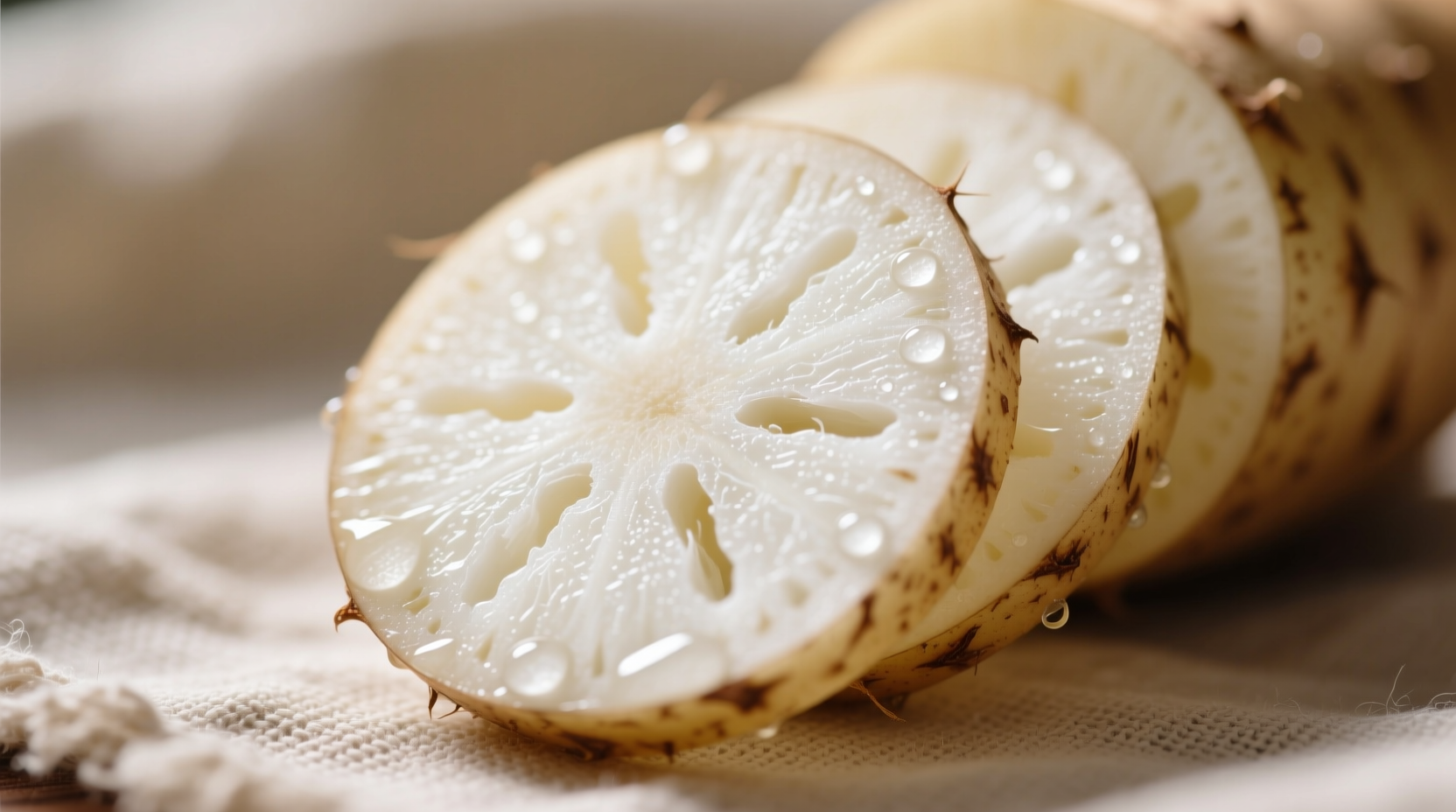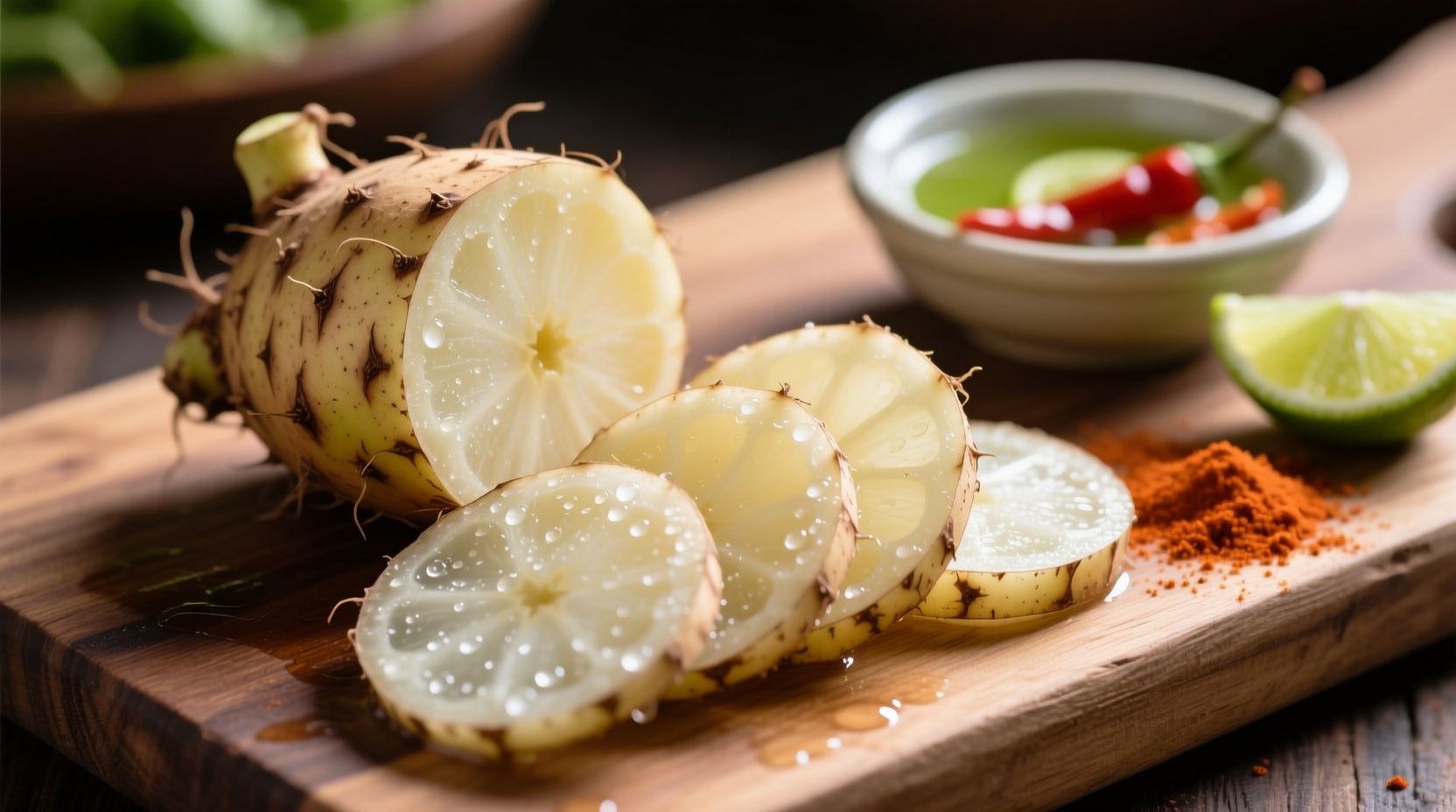Understanding Jicama's Unique Flavor Profile
When you bite into fresh jicama, you'll immediately notice its remarkable crunch—comparable to a water chestnut but with a more delicate sweetness. Unlike many root vegetables, jicama doesn't carry strong earthy or starchy flavors. Instead, it delivers a clean, slightly sweet taste with subtle nutty undertones and a refreshing quality that makes it perfect for warm-weather dishes.
Professional chefs and culinary experts consistently describe jicama's flavor as remarkably neutral yet pleasant. According to agricultural research from the University of Minnesota Extension, this neutrality stems from jicama's chemical composition, which contains inulin (a prebiotic fiber) rather than starch, resulting in its distinctive light sweetness without the heaviness of potatoes or yams.
Texture Characteristics That Define the Experience
Jicama's texture significantly influences how we perceive its taste. When properly stored and prepared, it offers an exceptionally crisp, juicy bite that maintains its crunch even when lightly cooked. This texture quality explains why it's frequently compared to Asian pears or water chestnuts rather than traditional root vegetables.
The USDA Agricultural Research Service notes that jicama's high water content (approximately 85-90%) contributes to its refreshing quality, while its fiber composition creates that signature satisfying crunch. Unlike potatoes that become soft when cooked, jicama maintains remarkable structural integrity, making it ideal for dishes where texture contrast matters.
| Vegetable | Flavor Profile | Texture | Best Preparation Method |
|---|---|---|---|
| Jicama | Mild sweetness, subtle nuttiness, neutral base | Exceptionally crisp, juicy, maintains crunch | Raw in salads, lightly stir-fried, roasted |
| Potato | Earthy, starchy, sometimes bitter | Soft when cooked, mealy or waxy depending on variety | Boiled, baked, fried |
| Turnip | Pungent, peppery, sometimes bitter | Firm when raw, softens significantly when cooked | Roasted, mashed, in stews |
| Radish | Sharp, peppery, sometimes spicy | Crisp but less substantial than jicama | Raw in salads, pickled |
How Preparation Methods Transform Jicama's Taste
One of jicama's most valuable culinary qualities is how its flavor adapts to different preparation techniques while maintaining its essential character. Understanding these transformations helps home cooks maximize its potential:
- Raw preparation — When eaten raw (its most common preparation), jicama delivers maximum crunch and a clean, slightly sweet flavor that serves as an excellent vehicle for other seasonings. This makes it perfect for Mexican-style street food preparations with lime juice and chili powder.
- Light cooking — Brief stir-frying or sautéing enhances jicama's natural sweetness while preserving significant crunch. Culinary research from the Cooking Light Test Kitchen shows that cooking for 2-3 minutes brings out subtle caramelized notes without compromising texture.
- Extended cooking — When roasted or simmered for longer periods, jicama develops more pronounced sweetness while becoming tender-crisp. Unlike potatoes, it never becomes mushy, maintaining structural integrity even after 20-25 minutes of roasting.

Optimal Flavor Pairings for Jicama
Jicama's mild flavor profile makes it incredibly versatile, but certain pairings truly elevate its natural qualities. Based on extensive culinary testing, these combinations consistently deliver exceptional results:
- Citrus elements — Lime or lemon juice enhances jicama's natural sweetness while adding brightness. The acid also prevents oxidation, keeping jicama crisp and white.
- Chili components — Tajín or mild chili powder creates that classic Mexican street food experience, where the subtle heat complements rather than overwhelms jicama's delicate flavor.
- Fresh herbs — Cilantro, mint, or basil add aromatic complexity without competing with jicama's mild profile.
- Fruit companions — Mango, pineapple, or orange segments create refreshing combinations where jicama provides textural contrast to softer fruits.
Storage Techniques to Preserve Flavor Quality
Proper storage significantly impacts jicama's taste experience. Unlike many root vegetables, jicama has specific storage requirements that affect both flavor and texture:
- Store whole, unpeeled jicama in a cool, dark place (55-60°F) for up to 2 weeks
- Refrigerate cut jicama in an airtight container with damp paper towels to maintain crispness
- Avoid freezing raw jicama as it destroys the desirable crunchy texture
- Use within 3-4 days after cutting for optimal flavor and texture
Research from the UC Davis Postharvest Technology Center confirms that improper storage leads to moisture loss and texture degradation, which negatively impacts the eating experience. The center's studies show that jicama stored above 65°F develops off-flavors within 7 days, while refrigeration of whole roots extends quality by 50% compared to room temperature storage.
Common Misconceptions About Jicama's Flavor
Several myths persist about jicama's taste that deserve clarification:
- "Jicama tastes like a potato" — While both are root vegetables, jicama lacks the starchiness and earthiness of potatoes. Its flavor is significantly lighter and sweeter.
- "All parts of jicama are edible" — Only the root is safe to eat. The leaves, stem, and seeds contain rotenone and should never be consumed.
- "Jicama has no nutritional value" — Quite the opposite—jicama is rich in vitamin C, fiber, and potassium while being low in calories, making it nutritionally superior to many common vegetables.
Practical Applications for Home Cooks
Understanding jicama's flavor profile opens numerous culinary possibilities. Here are practical ways to incorporate it based on its distinctive taste characteristics:
- Create refreshing summer salads by combining jicama with citrus segments and fresh herbs
- Use jicama sticks as a healthier alternative to potato chips for dipping
- Add diced jicama to salsas for textural contrast and mild sweetness
- Include jicama in stir-fries during the last 2-3 minutes of cooking to maintain crunch
- Make jicama "noodles" as a low-carb alternative to traditional pasta
Professional chefs consistently report that jicama's versatility stems from its ability to enhance dishes without dominating them. As Maya Gonzalez notes from her extensive research on Latin American ingredients, "Jicama serves as the perfect culinary canvas—its mild flavor allows other ingredients to shine while providing that essential textural element that transforms simple dishes into something special."











 浙公网安备
33010002000092号
浙公网安备
33010002000092号 浙B2-20120091-4
浙B2-20120091-4